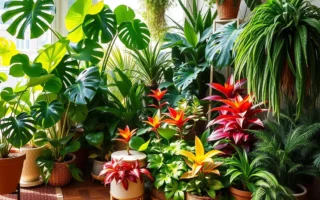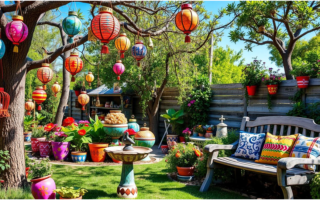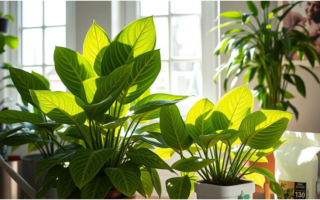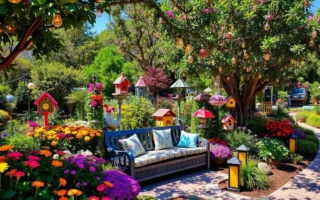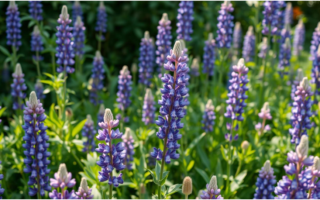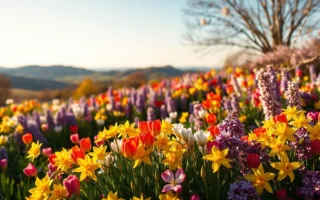Table of Contents
When you enter the desert, you find plants that make your landscape better. These plants can handle tough conditions and need little care. They’re perfect for a beautiful, easy-to-maintain outdoor area. Plus, they help you use less water.
Thank you for reading this post, don't forget to subscribe!Choosing the right desert plants can make your outdoor space amazing. You can pick from many types, like succulents and cacti. With the right mix, your space will come alive and feel peaceful.
Key Takeaways
- Desert flora offers a unique and stunning array of plants in the desert to enhance your landscape
- Drought-resistant plants are ideal for creating a low-maintenance outdoor space
- Desert plants can thrive in harsh conditions, making them perfect for arid climates
- Incorporating desert flora into your design can help minimize water consumption
- Choosing the right plants in the desert can create a breathtaking landscape that showcases natural beauty
- Desert flora offers endless possibilities for design and creativity
Understanding the Unique World of Desert Plants
Exploring arid climate vegetation reveals the amazing adaptations of succulents and cacti. These plants have evolved to live in tough environments. They are great for landscaping where water is scarce. Adding succulents and cacti to your outdoor space can make it look stunning and easy to care for.
Desert plants are special because they can store water and handle extreme temperatures. They are perfect for gardeners who want to save water. By picking the right desert plants, you can make a beautiful, low-maintenance outdoor area.
What Makes Desert Plants Special
Desert plants have evolved to survive in dry places. Succulents have thick leaves that hold water, letting them go without rain for a long time. Cacti have sharp spines that keep predators away and help them lose less water.
Natural Adaptation Mechanisms
Desert plants have special roots to grab water and nutrients from the soil. Some, like cacti, have deep roots to find water deep down. Others, like succulents, have shallow roots that spread out to catch moisture.
Benefits of Desert Plant Landscaping
Using desert plants in landscaping has many advantages. They need less water and care, but they add a unique beauty to your outdoor area. By using succulents and cacti in your design, you can create a beautiful, sustainable space that thrives in tough conditions.
Native Plants in the Desert: A Complete Guide
Creating a beautiful desert landscape is easy with native desert plants. These plants have learned to live in the desert’s tough conditions. They save water, which means you don’t have to water them as often.
Desert plants have special ways to survive and even grow in the desert. By picking native plants, you make a landscape that’s good for the environment. It also helps local animals. You can choose from shrubs, trees, and groundcovers, each with its own look and use.
- Choose plants that fit your climate and soil
- Think about the plant’s size when it’s fully grown
- Water them right, based on their natural needs
Follow these tips and pick the right plants. You’ll have a stunning desert landscape that’s good for the planet and looks amazing.
Essential Desert Succulents for Your Garden
Succulents are great for desert gardens because they can handle dry conditions well. They store water in their leaves, stems, or roots. This makes them perfect for gardeners who want to save water. Succulents come in many shapes and sizes, adding elegance to any garden.
There are many types of succulents, like aloe, agave, and echeveria. Aloe plants are known for their healing properties. Agave plants are loved for their unique shapes. Echeveria plants are famous for their rosettes and bright colors.
Popular Succulent Varieties
- Aloe vera: known for its healing properties
- Agave americana: prized for its striking architectural shape
- Echeveria elegans: popular for its beautiful rosettes and vibrant colors
Design Tips with Succulents
To make a beautiful desert garden, mix succulents with other plants and hardscapes. Use succulents as a centerpiece or border to add texture. They are easy to care for and look amazing, making them a great choice for a sustainable garden.
| Succulent Type | Watering Requirements | Sunlight Requirements |
| Aloe vera | Infrequent watering | Full sun to partial shade |
| Agave americana | Rare watering | Full sun |
| Echeveria elegans | Occasional watering | Partial shade to full sun |
Magnificent Cacti Species for Desert Gardens
Cacti are a favorite for desert gardens because they’re easy to care for. They thrive in the arid climate vegetation of the desert, where water is scarce. Their unique shapes and sizes bring elegance to any garden.
Some popular cacti for desert gardens include:
- Saguaro: A large, tree-like cacti that can grow up to 70 feet tall
- Prickly Pear: A small to medium-sized cacti with flat, round pads
- Barrel Cactus: A medium-sized cacti with a rounded, barrel-shaped body
These cacti are not just beautiful. They also offer shade, help conserve water, and attract wildlife. They’re a great choice for any desert flora.
Adding cacti to your desert garden can make it more beautiful and sustainable. They’re perfect for gardeners who want a low-maintenance, striking landscape. With the right care, your cacti will thrive for years.
| Cacti Species | Description | Benefits |
| Saguaro | Large, tree-like cacti | Provides shade, attracts wildlife |
| Prickly Pear | Small to medium-sized cacti | Conserves water, adds visual interest |
| Barrel Cactus | Medium-sized cacti with rounded body | Provides shade, attracts pollinators |
Drought-Resistant Flowering Plants for Desert Landscapes
Drought-resistant plants are essential for a beautiful desert landscape. They can handle extreme temperatures and save water. Flowering plants add color to your space.
Popular native desert plants include lantana, zinnia, and marigold. They are beautiful and easy to care for. Adding these plants makes your outdoor space unique and showcases desert plant adaptation.
Spring Bloomers
In spring, desert landscapes burst with color. Cactus flowers, desert marigold, and brittlebrush are popular. They are drought-resistant and perfect for desert gardens.
Year-Round Flowering Options
For color all year, use lantana, zinnia, and marigold. These plants flower year-round. Choosing native desert plants means a low-maintenance, beautiful landscape.
Color Planning for Desert Gardens
Color planning for desert gardens is endless. Mix flowers like lantana, zinnia, and marigold for a stunning look. Drought-resistant plants make your landscape beautiful and easy to care for.
| Plant | Color | Bloom Time |
| Lantana | Pink, Yellow, Orange | Year-Round |
| Zinnia | Pink, Orange, White | Year-Round |
| Marigold | Yellow, Orange | Year-Round |
Creating a Sustainable Desert Garden Layout
Designing a desert garden means understanding desert landscaping and the plants that love dry air. Xerophytes, like cacti and succulents, are perfect for saving water. They make your garden beautiful and easy to care for.
Here are some tips for a stunning desert garden:
- Choose a variety of arid climate vegetation for texture, color, and interest all year.
- Use rocks, gravel, and sand for a pretty and water-saving ground cover.
- Include both tall and short plants for depth and dimension.
By using these tips and adding xerophytes and other drought-tolerant plants, you’ll have a stunning desert garden. It will show off the beauty of desert landscaping. With the right care, your garden will flourish in the dry climate and be a beautiful spot for years.
| Plant Type | Water Requirements | Maintenance Needs |
| Cacti | Low | Low |
| Succulents | Low | Low |
| Desert Flowers | Medium | Medium |
Water-Wise Maintenance Tips for Desert Plants
Proper watering is key for desert plants. Succulents and cacti need less water but still need care. Knowing how to water them right is important.
To avoid drowning your plants, use smart watering methods. Drip irrigation systems are great because they water the roots directly. Mulch also helps keep the soil moist, so you don’t have to water as often.
Irrigation Strategies
- Water plants in the early morning or evening to minimize evaporation
- Use a moisture meter to check the soil moisture levels
- Avoid getting water on the leaves or stems to prevent fungal diseases
Seasonal Care Guidelines
Desert plants need different care at different times. In summer, they might need more water. In winter, they might need less. Knowing this helps keep them healthy.
Common Problems and Solutions
| Problem | Solution |
| Pests | Use organic pest control methods, such as neem oil or insecticidal soap |
| Diseases | Remove infected plants or plant parts, and improve air circulation |
| Nutrient deficiencies | Fertilize plants with a balanced, water-soluble fertilizer |
By following these tips, you can create a stunning desert garden. It will show off the beauty of drought-resistant plants and their amazing ability to adapt to the desert.
Combining Different Desert Plant Species for Maximum Impact
Creating a stunning desert landscape is easier with different desert plant species. Mixing desert flora, native desert plants, and succulents makes your outdoor space unique and breathtaking.
To start, here are some tips:
- Choose plants that complement each other in texture, color, and size.
- Make sure each plant’s growing conditions match your desert landscape.
- Feel free to experiment with new plant combinations for a unique look.
Pairing succulents with native desert plants like cacti or yucca is popular. This mix contrasts textures and adds interest. By mixing desert flora, you create a beautiful, sustainable outdoor space that highlights the desert’s unique beauty.
Follow these tips and try different desert flora combinations. You’ll create a stunning desert landscape that showcases native desert plants and succulents.
| Plant Type | Characteristics | Growing Conditions |
| Succulents | Thick, fleshy leaves or stems | Full sun, well-draining soil |
| Native Desert Plants | Drought-tolerant, adapted to desert conditions | Full sun, low water requirements |
Conclusion: Embracing the Beauty of Desert Flora in Your Landscape
Starting your desert landscape journey? The real beauty is in the unique plants in the desert. These hardy plants not only survive but also add beauty to your outdoor space. They come in vibrant colors and shapes, making your garden a work of art.
Choosing the right plants and designing your garden with care is key. You’ll create a beautiful, water-saving oasis. It will show off the amazing variety of desert plants. You can pick from bold cacti, delicate succulents, or stunning flowers, each adding to your desert landscaping masterpiece.
To make your desert garden a success, learn about the special needs of these plants. This guide will help you create a stunning, eco-friendly outdoor space. It will celebrate the desert’s beauty in every way.
FAQ
What are the unique characteristics of desert plants?
Desert plants have special traits to survive in dry places. They have: – Small leaves to lose less water – Special ways to store water – Waxy coatings to stop water from evaporating – Deep roots to find water deep down – They can sleep during dry times These features help desert plants live and grow well in the desert.
What are the benefits of using desert plants in landscaping?
Desert plants are great for gardens. They help save water and need little care. They also add beauty and attract wildlife.
What are some popular native desert plants I should consider?
Popular desert plants include: – Agave, with its unique shape – Yucca, known for its long leaves and flowers – Ocotillo, a shrub with red flowers – Creosote bush, a common desert plant with yellow flowers These plants are well-suited for the desert.
How can I care for desert succulents in my garden?
To care for succulents: – Use soil that drains well to avoid root rot – They need lots of sunlight, at least 6 hours a day – Water them only when the soil is dry – Protect them from cold in winter
What are some drought-resistant flowering plants I can use in my desert landscape?
Good flowering plants for the desert include: – Lantana, with its colorful flowers – Zinnia, a variety of colors and easy to grow – Marigold, adds color and is heat-tolerant – Gaillardia, or blanket flowers, in yellow, red, and orange These plants are perfect for desert gardens.
How can I create a sustainable desert garden layout?
For a sustainable desert garden: – Pick plants that don’t need much water and are native – Group plants by their water needs – Use gravel and rocks instead of grass – Use drip irrigation to water plants directly – Mulch helps keep soil moist and stops weeds


